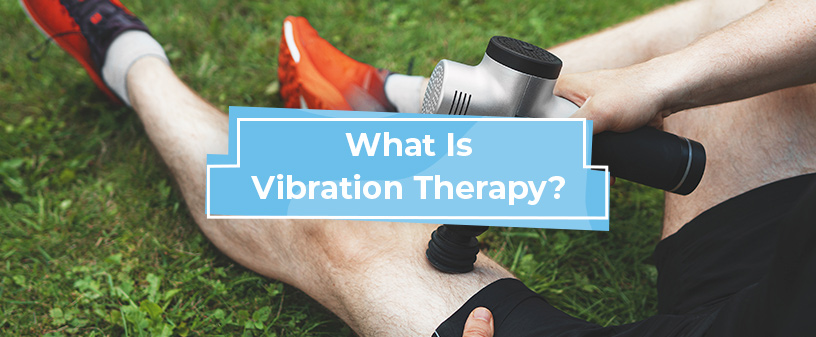
Vibration therapy uses sound vibrations to treat pain, muscle stiffness and other conditions, as well as help your body heal after an injury, like a broken bone. How does vibration therapy work, and how effective is it? We have the answers to your questions, and much more, below.
How Vibration Therapy Works
How do vibrations affect your body, bones and muscles? Vibrations cause your muscles to contract and relax. They also spur bones to produce osteoblasts, which are the cells responsible for building your bones.
Physicians use two types of vibration therapy:
- Whole body: Whole-body vibration therapy encompasses your entire body. During this kind of treatment, you’ll stand, sit or lay down on a machine that rests on a platform. This platform vibrates, sending sound waves throughout your body and causing your muscles to contract and relax.
- Localized: Instead of a platform, a hand-held device is used for localized vibration therapy. Like whole-body vibration therapy, you may sit, stand or lay down depending on the area you’re treating. For example, if your calf or thigh muscles are being treated, your doctor may have you lay down and then turn on the device.
Platforms and hand-held tools for vibration therapy vary in the types of waves they produce. Platforms, for instance, may only produce vertical vibrations, while a portable device may create horizontal and vertical sound waves to reach your muscles. Doctors can even customize the frequency and intensity of vibrations depending on your condition.
Who Vibration Therapy Helps
People with chronic pain often use vibration therapy because of its ability to relax muscles, though several other medical conditions use vibration therapy with success. These conditions include:
- Muscle or bone injury: According to research, vibration therapy may help stimulate bone formation and enhance overall bone strength. Vibration therapy can also serve to strengthen muscle over time.
- Parkinson’s disease: Studies have shown that vibration therapy may help mitigate the short-term effects of Parkinson’s disease, such as decreasing muscle tremors and rigidity.
- Arthritis: By reducing joint pain, preserving bone mass and improving functional ability, vibration therapy can help alleviate the pain caused by arthritis. People with rheumatoid arthritis may see a significant positive effect from vibration therapy. In one study, participants’ amount of functionality increased, and their fatigue decreased from two 15-minute sessions each week for three months.
- Multiple sclerosis (MS): Because vibration therapy is thought to help spur muscles to be more efficient as well as to build bone, it has been increasingly used as a treatment technique for muscle-related diseases like MS.
- Stroke: Stroke survivors who suffer spasms as a result of altered muscle tone can potentially mitigate the frequency of muscle spasms with regular vibration therapy sessions.
Vibration therapy does have its risks, however, as intense vibrations can cause back pain and even injuries to your lower back. Your doctor may advise you to forego vibration therapy for pain or another condition if you:
- Use blood thinners
- Are pregnant
- Have diabetes or heart disease
If you have one of these conditions, your physician may suggest an alternative treatment like physical or massage therapy in addition to diet and exercise changes.

How Vibration Therapy Heals
Vibration therapy is popular among patients because of its effectiveness. Research shows that vibration therapy can help:
- Increase bone density
- Decrease back pain
- Improve muscle mass
- Lower joint pain
- Raise metabolic rates
- Diminish muscle soreness
- Improve healing and recovery times
A significant research challenge of vibration therapy is that the intensity and frequency of the therapy influence its long- and short-term effects. Because of this factor, it’s difficult to reach a conclusion that applies to every patient. Two 15-minute sessions may improve one set of patient’s symptoms, but another group of participants may need three treatments to see results.
Even with these research challenges, it’s clear that acoustic vibration therapy does benefit many patients and offer relief from painful conditions like rheumatoid arthritis. It’s just another service that sound provides.
Beyond treating specific conditions, there are everyday advantages to participating in vibration therapy. Because vibration therapy can help with strengthening muscle and increasing bone density, incorporating vibration therapy as a component of a comprehensive therapy regimen can bring a broad set of health benefits.
In fact, adding vibrations into your regular exercise routine can greatly strengthen your muscles and improve your cardiovascular health. This is because motor nerves and muscle fibers respond even more to vibrations than to the simple deliberate muscle contractions we do as we work out. With whole-body vibration exercises, you can work your muscles and joints in a new way to get even greater benefits from working out.
The benefits of vibration therapy with exercise include:
- Weight loss: Because vibrations can raise your metabolic rate, it may be easier to lose and keep off small amounts of weight.
- Improved circulation: Stimulating the body through vibration therapy can promote better blood flow overall.
- Decreased stress: Vibration therapy may help you release tension and relax.
- Increased balance and flexibility: By stimulating muscle fibers, vibration therapy can help you engage more as you stretch.
- Healthier-looking skin: Improving circulation and flushing out toxins can naturally make your skin appear clearer and more radiant.
Along with whole-body vibration therapy, localized vibration therapy offers its own set of health benefits. As the application of vibration therapy to a specific area for healing, localized vibration therapy involves stimulating select muscle groups to enhance their functioning and mobility. In general, vertical vibrations are considered the most effective method to use when producing muscle contractions for health improvements.
Whether you’re looking for localized treatment through vibration therapy or more general health benefits, the power of sound may help your body heal.
Find Out More About Sound Therapy
Want to learn more about how sound is contributing to the medical field? Explore our blog or join the herd by subscribing to our Bull Bulletin today. We’ll send you the latest news and information about vibration therapy and more.






